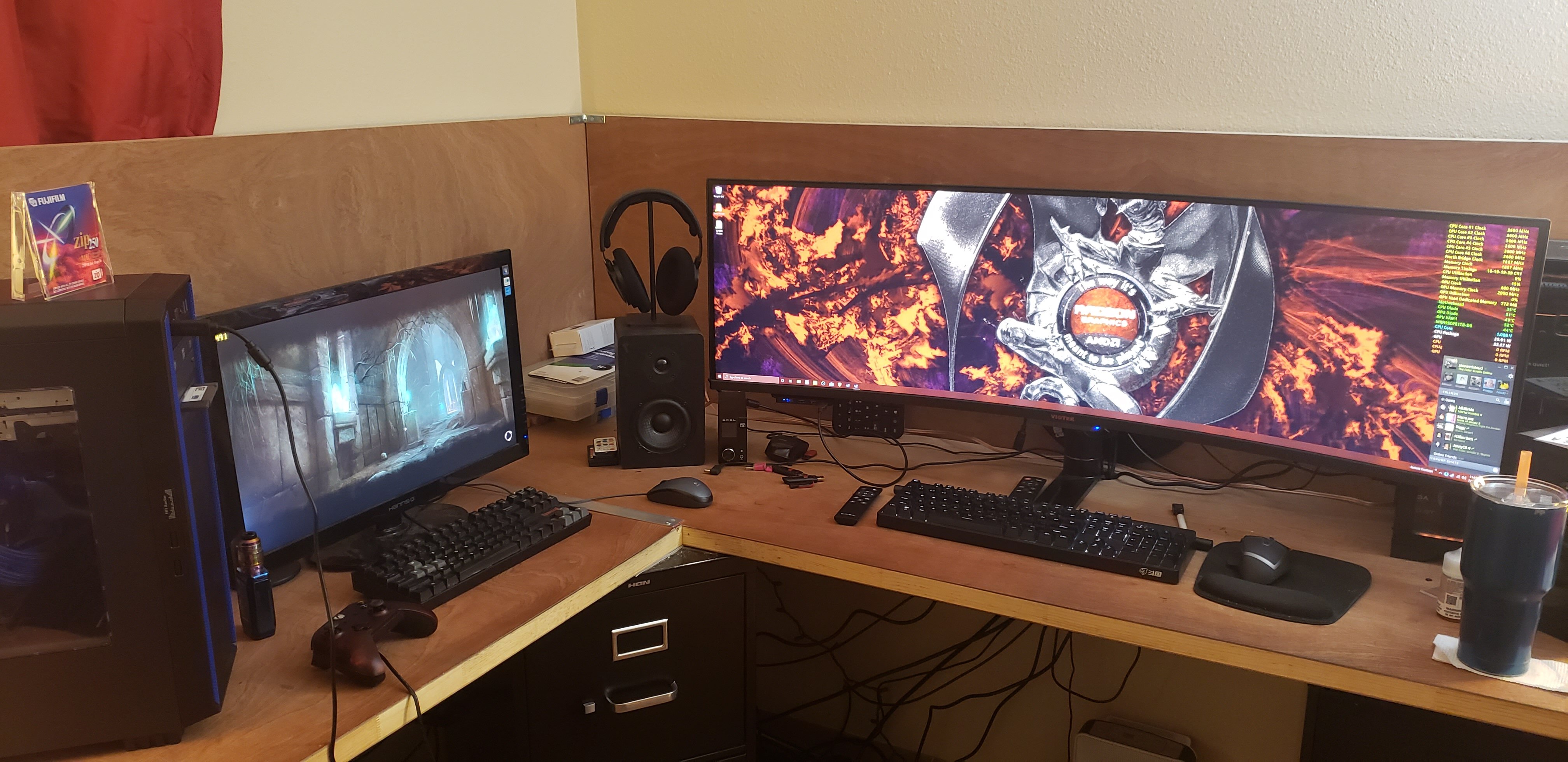Welcome to ExtremeHW
Welcome to ExtremeHW, register to take part in our community, don't worry this is a simple FREE process that requires minimal information for you to signup.
Registered users can:
- Start new topics and reply to others.
- Show off your PC using our Rig Creator feature.
- Subscribe to topics and forums to get updates.
- Get your own profile page to customize.
- Send personal messages to other members.
- Take advantage of site exclusive features.
- Upgrade to Premium to unlock additional sites features.
-
Posts
1,760 -
Joined
-
Last visited
-
Days Won
101 -
Feedback
0%
Content Type
Forums
Store
Events
Gallery
Profiles
Videos
Marketplace
Tutorials
Everything posted by pio
-
I actually have a router connected to WAN on another router right now (kinda). I did it on purpose to seperate the networks though. I have 2x "naked" routers (each with their own ISP). Those both plug into a PC on my rack, which connects the ISP's to my VPN together. Then the VPN'ed connection goes out to another router's WAN port, which that router is my "main" router for the whole house. As such, I have ZERO problems connecting directly to the "naked" networks behind the VPN'ed router, even though my actual connection is through the VPN to the internet. However, in MY instance, I cannot connect to the VPN'ed network from inside of the "naked" networks. It could be the PC in the middle, it could be a NAT setting.....idk. Not going to mess with it since it works though.
-
I've never had much luck with that option on consumer grade routers? I'm also a networking noob, so also a very fair point to call that out.
-
I'd like to further expand on this a tad. When you disable DHCP on the second router (or turn on AP mode), you'll NEED to plug the first router into Port 1 on the second router (or any port really besides WAN). When using a router as a switch, you DO NOT use the WAN port as it is there for your ISP connection in. In this instance, your second router is not connected directly to the ISP (for DHCP). So you'd wire it up as an unmanaged switch, aka, you'd use the 4 ports without the WAN (since switches don't have a WAN). And yes, this will work perfectly fine with like 99% of the routers I've ever played with. Most routers have basic switch functionality in them already, you just need to disable DHCP first (or enable AP mode). -------------------------- The way you were planning on wiring it up, by using the WAN port also in theory WILL work perfectly fine. However to use the WAN port, you'd leave DHCP enabled (or leave the router in router mode). This method WILL create basically a second network entirely off of the first one. As such, both routers will have completely isolated networks. You will be able to get into the first router's network from the second one, but NOT vice versa due to the WAN port on the second router being used. At least, that's been my experience. There might be like some port forwarding way to accomplish it or something, but yeah. I haven't been able to make bidirectional communication happen using this method, only the first method listed above.
-

Mailbox hit by a car... security camera thread.
pio replied to SoloCamo's topic in Chit Chat General
Well, I mean if I personally break something I'll fix it anyway just because that's common courtesy. Up here in WA State though, a landlord asking a tenant to make home or property repairs is 100% illegal here. If its their property, its their problem to fix it, and the law states they HAVE to fix it. Kinda crappy for good landlords that have horrible tenants honestly, but it DOES help out the good tenants with crappy landlords though. -

Mailbox hit by a car... security camera thread.
pio replied to SoloCamo's topic in Chit Chat General
Wait a second, WHAT? You're renting, that's literally not your mailbox, not your problem bro. That can't be legal for the landlord to have YOU make repairs on THEIR house, can it? I understand the want and still need for having better security cameras, but reading that just blew my mind. Also, can also confirm Arlo cameras suck. My parents had a set at their old house, and my brother in law's truck was lit on fire (vandalism) right in front of the house. We caught enough footage that the entire neighborhood could tell who did it when we were asking around who it was (it was the neighbor who did it). But the footage unfortunately wasn't good enough for the police, since it didn't CLEARLY catch his face, but yet he was wearing the same clothes as in the video, live when interviewed. Whatever, that's an entirely different argument too....... Point is, the cameras failed to capture the moment that the dude tossed the molotov into the truck, but it caught him coming back to check on his fire and pour gasoline on it. -

Mailbox hit by a car... security camera thread.
pio replied to SoloCamo's topic in Chit Chat General
I'm not too good with cameras and security systems, but is there a way you can setup a DVR, like with a PC or something, that'll just record the Arlo cameras all the time? Pretty sure OBS could handle that. Idk about "data retention" though......like overriding old files the way a regular DVR would do when the drives get full. Idk, just trying to think of ways to make your existing stuff work better. -
Welcome over here to the good side of forums!
-
Ahhh yes, the Aurora Strip in Seattle.......... Oh wait, those aren't all in Seattle. Must be something with the name then........
-
I'll just say this, my 7900XTX is a wonderful GPU. I definitely have typical "brand new AMD" bugs, which I hate to admit being that I enjoy the card so much. Their software is honestly pretty great too...........when it works. My 6900XT doesn't have anywhere near the issues the 7900 has, so I know its a weird architecture bug of some kind I'm having. It'd be a shame to see AMD drop out of the graphics business, they've been at it for decades. I don't think they'll be leaving either. They HAVE admitted recently (I think we have the article somewhere) that they were going to focus more on the midrange type cards. They have also admitted recently to bringing back multi-GPU, to an extent. I get the feeling they're going to release a midrange card, and use their crossfire knowledge and capabilities to make on PCB or maybe even on die multi GPU to make their higher end cards. That's my guess. Totally 100% my own opinion and guess on the situation. Just seems like that might be the direction they're headed.
-
Saw absolutely nothing here last night. I'll look again tonight, but yeah nothing up here in eastern WA state.
-
How are you liking Fi? I'm curious what speeds their hotspot is, my Visible (Verizon network) works wonderful, but the 5Mbps cap on the hotspot is kinda tough. Always on the lookout for other Verizon networks that might have a better hotspot plan.
-

Intel's next-gen desktop CPUs have reportedly leaked
pio replied to Barefooter's topic in Hardware News
Of course the leaks are on purpose. Marketing at its finest right here. I don't understand Intel's core and thread count stuff they've been pulling to be honest. P and E cores, hyper threading only on part of the cores, I just can't keep up. AMD is definitely keeping their CPU designs a lot simpler to understand anyway. I just hope these new CPU's run better, I've been reading a lot of people having problems with the 14900's and heat. AMD's Ryzen 7000 series runs quite warm too. We're about at that point where something's gotta change in the manufacturing now, reaching the point of limited returns. -
So hooking it up with an intake hose with a funnel, directly off the tap isn't gonna work?
-
-
edit - dp - please remove
-
I have a set of calipers here, I can just measure the fittings I have on hand. I'm PRETTY SURE they're 3/8 ID / 5/8 OD, but I'll double check the measurement before ordering. Just going to order 9x more fittings that look close enough to these ones, that'll fit the 2x Y splitters (3x each), and the fill and drain ports (last one is for the funnel fill tube). I have EXACTLY enough fittings as is to fit everything else (CPU block, rad, res). This is just simply because I'm trying to go above and beyond on this loop with the fill / drain ports that I need more. I think because of where these parts all came from, just a simple hot water sink cleaning should be sufficient, and then rinse with distilled. So I'm not AS worried about that anymore. Also, as I said last post, I need to fabricate a hose with a fitting on the end, and a funnel on the other anyway for filling it. I'll just hook the kitchen sink up with that.
-
You know what, I forgot all about mod my mods. I just put everything I need in the cart, and I'm at like $90. Very not bad. I'll re-measure what I have here, make sure I"m picking up the right stuff as far as sizes and looks go so it all matches. Those AlphaCool small 3 way "generic block with G1/4 openings" I think match something I have, so I'll pick those up (and I like that they're smaller and cheaper). Because I'm putting in a fill and drain port in the loop. Due to space, I only have 2 ports available on the res, also I cannot GET to the res fill port. So was going to Y it right behind the res between it and CPU, and run a line up to the top for a fill port, keep the water level higher than the res, and it should fill up. Same thing for drain port, figured if I was going to that extreme to fill it, might as well plumb in a drain port. I think I'm sold on just running the sink through it, I'll have to assemble a hose with a funnel and G1/4 fitting at the end anyway to go into the fill port. So why not just screw that into the rad, and double check it! Noted about EDPM. Will make sure that's what I order. I need to order some RC race car parts too......
-
I planned on dilutting the antifreeze with water, yes. I have "pure" antifreeze, non mixed. So obviously I need to mix it 50/50 for my car (bought 2 gallons, for car + PC combined). The mixture for the PC however, I'm unsure of. I don't think I'd need a 50/50 mix in a PC, maybe 25/75? I'm cool with "man cleaning". Is there a cheap attachment somewhere for the sink faucet? Budget is definitely king here, this is all going in an old, unloved FX build. Y splitters - I'd prefer to use proper fittings so everything looks similar. I've got "EK Quantum Torque" fittings right now, but only enough for the main loop (no drain / fill ports). So I'd need to pickup 6 more fittings I believe for the two Y splits? I think that was what I came up with. Ace sells appropriate tubing? Ace is literally in my backyard..........
-
Alright, so a few of you guys have sent me some stuff for water loops (ty ty ty to those who helped btw). I'm SUPER excited to get this going........ Question though.......I need a few parts, can anybody help me deal shop? I need: 2x tubing Y splitters Tubing (lots, going for an external rad) Fill and drain ports I want budget, I want to do this like a junkyard car build, find stuff for cheap or MacGyver something. I also don't want it to be "wrong" either (use the wrong tubing and it corrodes or something stupid). Also - I have car antifreeze to use. Is that okay? Another question too - How do I clean this all up before I install it? And is car antifreeze okay to use in a PC loop? HELP??????
-
A lot of GoG titles don't seem to have this cheating issue......... Granted, they're not major social networking games like LoL or Fortnite, or whatever popular garbage of today either. I have zero problems just doing away with "anti-cheat" software all together. Get us back to dedicated servers, where server admins can just kick or ban cheating players, problem solved. Put the power of anti cheat BACK into the player's hands. My opinion anyway, since cheaters will always cheat, hackers will always hack. Obviously these software solutions aren't working, and neither is DRM.
-
I've seen a LOT of people run the triple bottom + top monitor option on the battlestation threads and whatnot. It's a popular choice and kinda makes sense. I'm just trying to think of it from a practicality perspective. If I've already got 3 monitors lined up and I'm wanting to play a driving or flight game, I'd absolutely want Eyefinity / Surround on. Shooters, personally I'd want single monitor a lot of the times due to HUD problems. So that's why I was saying that, because that's what I personally would want out of my monitor setup (which I'm wanting to ditch my ultrawide for eyefinity again ). I get the concern about going below 120Hz, that's why I went Ultrawide this go around was to try out higher refresh rates. My old Eyefinity was all 60Hz IPS. And yup, budget is exactly the reason I'm still stuck on this 49" Ultrawide. Buying 3x nicer 4k, 120Hz panels gets spendy quickly.
-
No, but I used to run Eyefinity from 2007 till about 2017, and then 5120x1440 @ 120Hz (32:9 ultrawide) from 2020 till now. I use Radeon cards at the moment, but same idea. My current monitor is ROUGHLY equivalent to two 27" 1440p / 120Hz panels. Your 3090 will do OLDER titles fine with surround. No problem at all. More modern like 2020 and newer titles, you'll probably struggle. That's why I said just leave it open as an OPTION by having the 3 monitors match. You don't HAVE to use Surround, but if you're going for that style monitor setup anyway........why not allow yourself the option to use it if you want to?
-
You're over thinking it. The max resolutions and whatnot, reported by your GPU manufacturer, are for each monitor, not the entire array. You're good to go, outside of GPU horsepower at that res. I think you're going to find a 3090 a tad anemic for that resolution with any sort of 3d loads like gaming. All depends on what you're doing though. Personally, I'd suggest the 3x bottom monitors all matching if you can. That way you can turn on "Nvidia Surround" on games that you want to use it on (and still retain that top monitor function as a secondary).







